In-depth Analysis of Orion: Aggregating Ultimate Liquidity to Drive a New Landscape in Crypto Trading
Written by: @yelsanwong
Advisor: @CryptoScott_ETH
TL;DR
- Orion integrates decentralized DEXs and CEXs liquidity into a single access point through liquidity aggregation, virtual order books, and a highly secure cross-chain bridge, significantly simplifying the trading process for users and providing a seamless user experience.
- Recently, Orion launched the Refer&Earn campaign to encourage influencers and loyal users to refer new users, offering corresponding $ORN and trading fee discounts as incentives. This reward-based referral mechanism not only rapidly increases the platform's user base but also spreads Orion's brand through the natural social networks of community members, achieving organic growth.
- Orion recently introduced the BRC20 cross-chain bridge, greatly expanding the functionality of the Orion protocol, enabling the creation and exchange of tokens on the Bitcoin network, laying a critical foundation for the expansion of the Bitcoin finance (BTCFi) ecosystem. This advancement enriches the application scenarios and value of Bitcoin while providing Orion with a unique opportunity to connect BTCFi with the broader decentralized finance (DeFi) ecosystem. Given the rapid expansion of the Bitcoin ecosystem last year, we expect BTCFi to become a rapidly growing field, and Orion, through its cross-chain bridge solution, is poised for significant growth in this area.
1. Project Overview
Orion Protocol was established in 2018 with the initial design aimed at providing a unified, decentralized trading solution. It connects to all major centralized exchanges (CEXs) and decentralized exchanges (DEXs) through a liquidity aggregator, allowing users to access the entire market's liquidity on its decentralized platform to obtain the best market price for any token.
Orion Protocol aims to improve trading efficiency, reduce costs, and provide a seamless user experience by integrating a highly secure cross-chain bridge and virtual order books. The core of the platform is its integration of dispersed market liquidity into a single access point, simplifying the trading process for users while maintaining the characteristics of high transparency, high security, and independence from intermediaries in DeFi.
In November 2023, Orion Protocol announced the rebranding of 'Orion Protocol' to 'Orion' to revitalize the protocol and provide a clearer and more targeted value proposition while expanding the utility and potential of the ORN token.
2. Project Background
2.1 Team Background
Alexey Koloskov (Founder & CEO)
Before serving as the CEO of Orion Protocol, Alexey was the Chief Architect at Waves, where he successfully led the architectural design and development of the Waves decentralized exchange. Since June 2017, Alexey has been the founder and CEO of Orion Protocol, leading the project for over six years, responsible for formulating company strategy, overseeing product development, and driving innovation and growth in the blockchain industry.
Kal Ali (Co-Founder & COO)
As an early strategic advisor and co-founder of Orion Protocol, Kal Ali currently also serves as a limited partner at Dominance Ventures, a venture capital firm that has participated in early investments in projects such as Cosmos, Gunzilla Games, and Avalanche.
2.2 Financing Situation
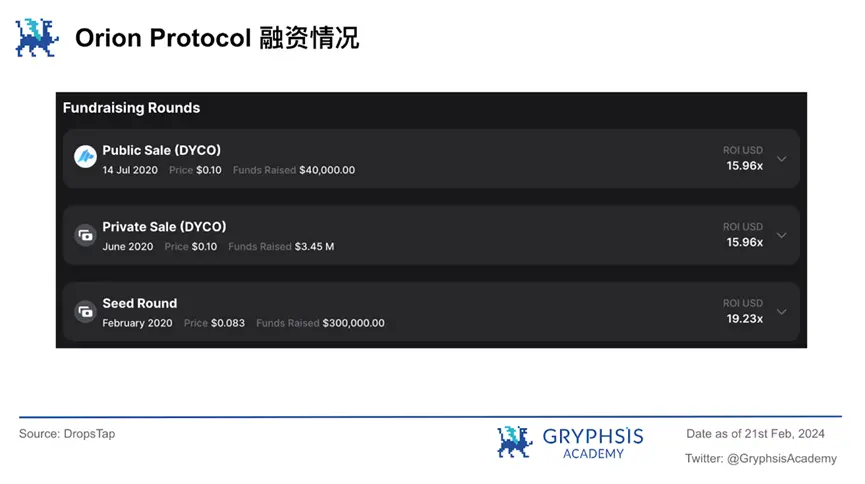
3. Products and Business
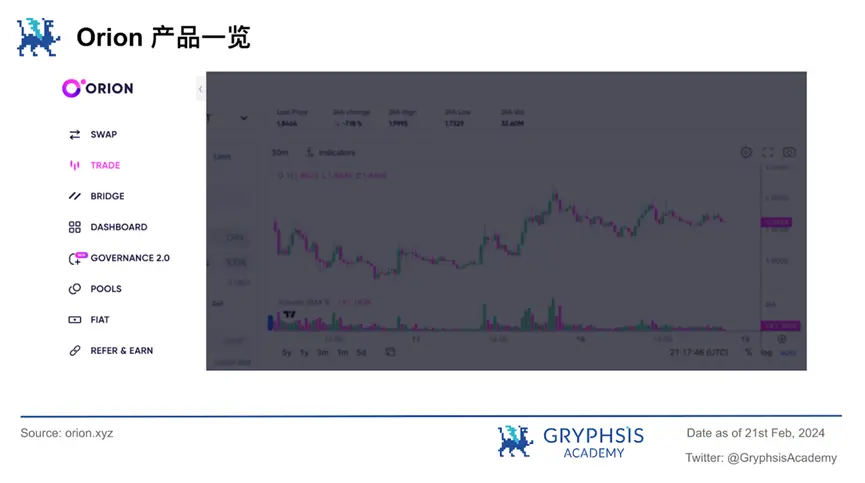
3.1 Orion Terminal
Orion Terminal, as the core product of Orion Protocol, provides real-time access and integration of multiple exchanges' order books through its unique liquidity aggregation mechanism. This mechanism covers a wide range of exchanges, including centralized and decentralized platforms, ensuring users can obtain the best trading prices and depth in the market from a single interface.
This innovation not only provides users with optimized trade execution and pricing strategies but also effectively reduces trading costs and enhances overall market efficiency. Below are the implementation paths of this mechanism.
3.1.1 deCEX Trading: Using CEXs in a Decentralized Manner
Through Orion Terminal, users do not need to create personal accounts on centralized exchanges, eliminating cumbersome procedures such as personal KYC. When users initiate a trade, it is sent to a liquidity node, also known as a liquidity provider, through atomic transactions (which complete all steps of the transaction in one go via smart contracts, ensuring that the transaction either fully succeeds or does not occur at all, with no intermediate state), and the node executes the trade on the CEX, after which users immediately receive their tokens. Unlike traditional DEXs that use AMM mechanisms, deCEX provides real-time order books, offering more precise and immediate trading data.
Safe Deviation (SD) Mechanism:
While atomic transactions may guarantee users can send trade requests at ideal prices under the premise of fund safety, how does Orion ensure users can complete trades at the best prices? To address this, Orion sets a Safe Deviation (SD) for trades.
In simple terms, SD is an automated preset trading slippage. In CEXs, for USDT trading pairs, where most trading pairs have sufficient liquidity, SD is set to 0; for non-USDT trading pairs (like ETH/BTC) on CEXs, a 0.4% SD is applied; for single swaps on DEXs, a 0.15% SD is applied, and for multi-step swaps, it multiplies 0.15% by the number of corresponding steps. During this process, Orion does not charge any additional fees beyond the actual commission and network fees calculated based on the order volume.
Unlike users setting their own slippage, while both SD and user-set slippage affect trading prices, SD, as a fixed, predefined mechanism, provides users with a degree of transparency and predictability regarding price fluctuations.
Even under extreme market conditions, the system will automatically take measures to facilitate trades. Additionally, the SD mechanism may adopt different coefficients based on varying market conditions (such as liquidity and volatility of trading pairs), providing flexibility and adaptability beyond what users can manually set for slippage, especially in cases of significant short-term price fluctuations.
However, the SD mechanism itself has certain shortcomings; for instance, a large transaction in a liquidity pool with insufficient reserves may significantly impact the token price in that pool, and a preset slippage of 0.15% may not be sufficient to handle such changes, leading to transaction failures.
Liquidity Nodes / Liquidity Providers:
During the trade execution process, Orion assigns orders to specific liquidity nodes through its virtual order book. To maintain the decentralized nature of the network and improve efficiency, Orion introduces a Delegated Proof of Liquidity (DPoL) mechanism.
Through this mechanism, liquidity nodes must stake ORN tokens to participate, with nodes that stake more likely to be chosen to execute trades. However, this selection process considers not only the amount staked but also the types of tokens provided by the node, the blockchain network it is on, and its reserve situation to ensure trades can be executed smoothly.
DPoL also allows users to participate in decision-making by delegating ORN tokens to specific liquidity nodes, thereby influencing the selection of nodes. This process aims to balance the interests of users and nodes, enhancing the decentralization of the network and user participation by allowing nodes to set trading fees and share profits with users.
Asset Security and Autonomy:
In terms of asset security and user control, Orion Terminal provides a model for trading directly from user wallets. Through the liquidity aggregator, users are essentially the order delegates; after creating an order through Orion, the aggregator interacts with liquidity nodes for execution. Each order's address, trading platform, and order quantity are all publicly viewable and verifiable.
This model enhances asset security, ensuring users' funds are always under their direct control, reducing the risks of fund theft and abuse present in traditional centralized exchanges. Even if Orion Terminal experiences a failure, the liquidity node network and smart contracts continue to operate normally, allowing users to continue trading through Orion's liquidity and economic services.
This design embodies the core of decentralization, allowing users to trade safely and freely without needing to trust any third party.
3.1.2 Transmuted AMM Price Curves: Using DEXs in a CEX-like Trading Manner
Traditionally, decentralized exchanges (DEXs) like Uniswap V3 use automated market maker (AMM) mechanisms, determining prices through their price curves, which differs from the clear listing of buy and sell orders on order books used by centralized exchanges (CEXs). AMM price curves make it difficult to directly compare their liquidity with the order books of centralized exchanges.
Orion's innovation lies in converting AMM price curves into traditional order book formats, allowing AMM liquidity from platforms like Uniswap V3 to be displayed and compared as if it were on centralized exchanges like Binance or OKX.
This conversion not only makes price comparisons easier but also allows for limit orders to be set on AMMs, enhancing trading opportunities. Furthermore, by converting AMM price curves into order books, Orion ensures that AMM liquidity can be seamlessly integrated and compared with CEXs, creating a unified trading platform for users.
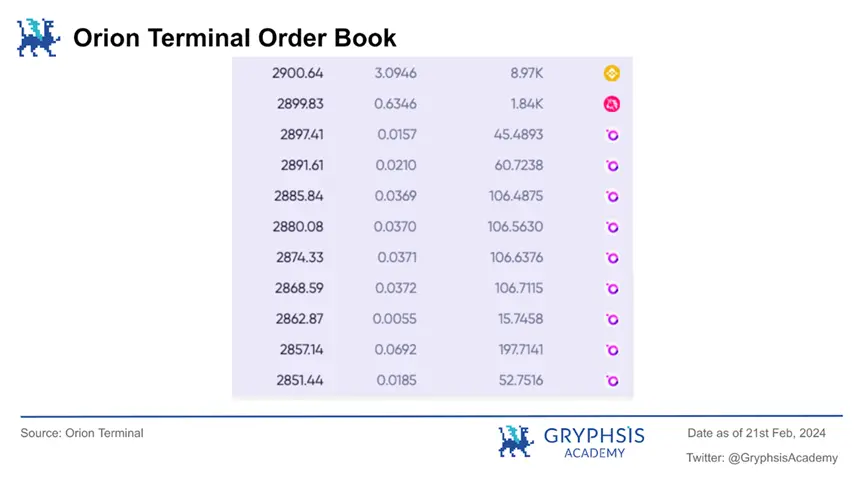
3.1.3 Virtual Order Books: Finding Optimal Price Paths by Combining DEXs and CEXs Order Books
Virtual Order Books (VOBs) combine the direct trading approach of traditional order books (OOB) with the liquidity model of automated market makers (AMMs), creating a unified trading platform. VOBs not only display direct trading information but also reveal potential liquidity advantages through multi-step swaps.
For example, a trade that exchanges Token A for Token C through an intermediate token (Token B). Continuously calculating complex swaps means it can constantly update and optimize trading opportunities, providing traders with new and competitive prices, as well as previously undiscovered arbitrage opportunities.
By integrating these three key technologies, Orion Terminal undoubtedly becomes the preliminary ideal form of a liquidity aggregation trading product, although its specific reliability and value discovery capabilities still need to be validated by the market.
3.2 Orion Bridge
Orion Bridge addresses the challenges of cross-chain trading in the cryptocurrency market to some extent, achieving a truly efficient decentralized cross-chain bridge. The core of this technology lies in its integration method, which first embeds cross-chain and cross-exchange liquidity aggregation directly into the backend of Orion Terminal, providing users with a seamless, fast, and secure trading environment. Compared to existing bridges, Orion Bridge offers an unrestricted, no-delay, no-order-rejection, no-fund-locking, and no-exploitation-risk trading experience, significantly addressing many issues present in other cross-chain bridges on the market.
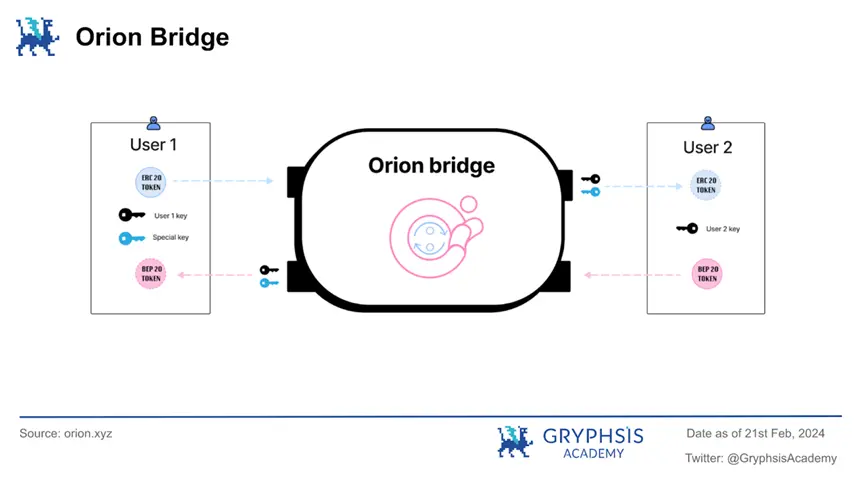
Orion Bridge is supported by three core technologies: Atomic Swaps, Peer-to-Peer Network (P2P Network), and Broker Network. Atomic swaps allow for instant exchanges of two assets across different blockchains without the need for wrapped assets or delays. P2P technology achieves true decentralization, enabling assets to be exchanged directly between individuals without the need for a central authority. The broker network ensures the immediacy and smoothness of transactions, regardless of the scale of the trade.
In the first iteration of Orion Bridge, seamless connectivity between Ethereum and BSC has been achieved, and the BRC20 cross-chain bridge will be launched soon, allowing BRC20 tokens to trade with EVM-compatible chains like MATIC and BSC. Notably, ORN is the only token with the BTCfi concept listed on Binance.
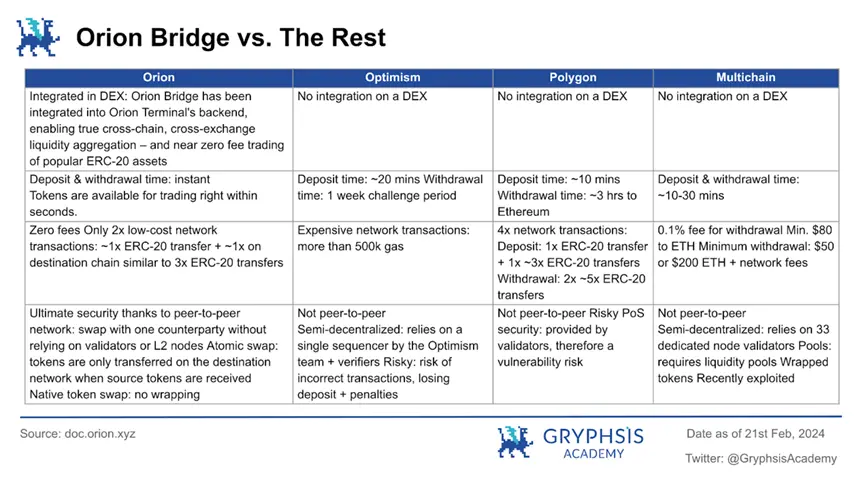
3.3 Orion Pools
Orion Pools is a decentralized liquidity pool platform built on the Uniswap V2 model. This platform allows users not only to contribute liquidity and create new liquidity pools but also to personalize their experience by adding custom logos, ensuring an active and vibrant trading environment.
The design philosophy of Orion Pools reflects a focus on empowering users, enabling them to create, contribute to, and customize liquidity pools through a simplified user interface and process.
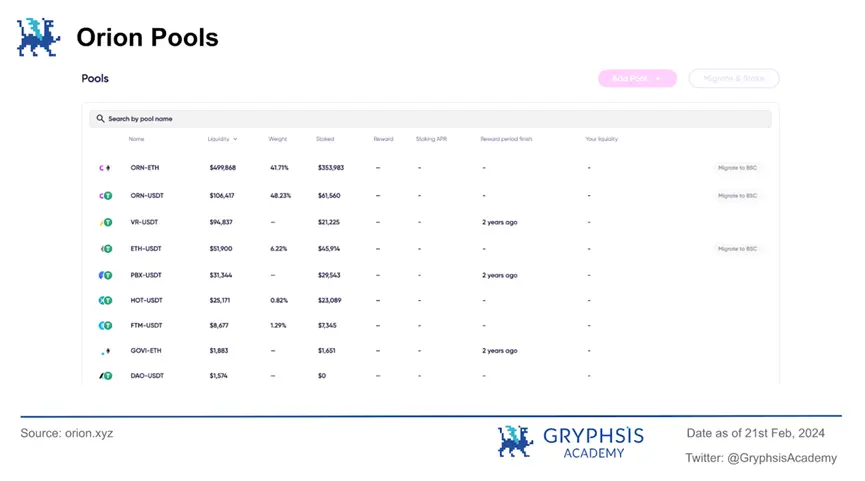
In terms of operational processes, Orion Pools provides intuitive guidance, allowing users to easily create new pools or add liquidity to existing ones. The process of creating a new pool includes selecting or adding new tokens, suggesting pairing with USDT to ensure integration across the Orion platform, uploading token icons (for new tokens), and completing transactions to confirm the creation of the new pool. The process of contributing liquidity involves selecting preferred pools, entering the amount of assets to contribute, and confirming the transaction through the wallet. These processes are not only user-friendly but also enhance the platform's liquidity and trading efficiency.
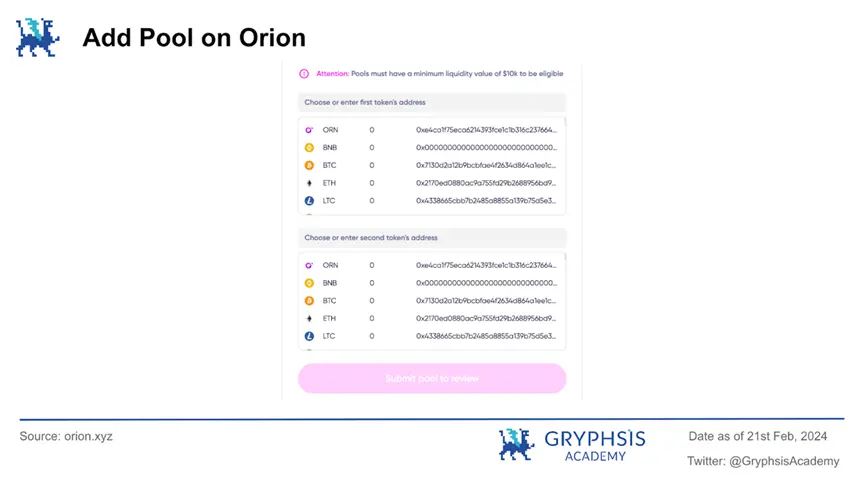
By contributing assets to liquidity pools, users facilitate seamless trading on the platform while earning a portion of the trading fees as rewards, creating a mutually beneficial relationship. Orion Pools not only provide opportunities for earning rewards but also allow users to become part of a broader trading ecosystem, enhancing their sense of participation and belonging.
With the implementation of a new governance and liquidity mining system, Orion Pools is transitioning to a more sustainable and growth-oriented model. The new system will take effect from December 5, 2023, emphasizing support for protocol growth and sustainability while ensuring alignment with user interests. This transition not only enhances the platform's attractiveness but is also expected to attract more users to participate in the Orion ecosystem.
3.4 Orion Widget
The Orion Widget launched by Orion Protocol is an innovative application designed for cryptocurrency trading platforms and decentralized application (dApp) developers, aimed at quickly implementing token trading functionality on any webpage or application through a simplified integration process. This tool leverages the liquidity of Orion's centralized and decentralized exchanges (CEX and DEX), allowing users to trade directly by connecting their wallets, thereby enhancing trading convenience and user experience.
The core advantage of the Orion Widget lies in its high customizability and ease of integration. Developers can customize the appearance and functionality of the Widget through a series of predefined parameters, including theme style, default trading assets, list of tradable assets, initial trading amounts, and fee assets, to meet the specific needs of different platforms and user groups. This flexibility ensures that the Widget can seamlessly integrate into various webpage and application environments while maintaining brand consistency and user-friendliness.
Additionally, the integration process for the Orion Widget is extremely simple, supporting integration via scripts and iframes, requiring almost no complex coding work. This significantly lowers the technical barrier, allowing even developers without a technical background to easily deploy trading functionalities on their platforms. This not only accelerates the development cycle but also reduces development costs, providing projects with greater flexibility and scalability.
In terms of token listings, the Orion Widget supports hundreds of tokens already listed by Orion Protocol and ensures support for unlisted tokens through its extensive liquidity sources, further expanding users' trading options. This feature is particularly suitable for projects looking to offer specific token trading services on their platforms without worrying about liquidity shortages or token support issues.
4. Growth Points
4.1 Refer & Earn for Rapid User Growth
Orion Protocol's Refer & Earn campaign is a plan aimed at expanding its user base. Through this program, Orion encourages influencers and loyal users to refer new users, offering $ORN tokens as rewards. Participants can apply to join this program by contacting @TradeOnOrion on Telegram.
Referrers share referral links, and referred users can enjoy a 10% discount on trading fees when trading at @TradeOnOrion, while referrers can earn rewards of over 70% based on the trading fees generated from their referrals. Rewards are distributed in real-time through $ORN tokens on the BNB Chain. As the program progresses, more opportunities will be opened for users who wish to become referrers.
Moreover, active referral networks and high trading volumes not only earn base rewards but also provide opportunities for additional $ORN token rewards on the leaderboard. Rankings on the leaderboard are based on the trading volume of the network within 14 days and the amount of ORN tokens in the wallet. Orion adjusts the leaderboard budget monthly to temporarily increase referral rewards, which are distributed hourly and can be claimed on the BNB chain.
This reward-based referral mechanism not only rapidly increases the platform's user base but also spreads Orion's brand through the natural social networks of community members, achieving organic growth. Community members directly benefit from their referral activities, and this mutually beneficial relationship enhances user loyalty and engagement with the platform.
At the same time, the Refer & Earn campaign incentivizes users trading through referral links with trading fee discounts, which not only directly reduces users' trading costs but may also attract more trading activity to shift to the Orion platform. As trading volume increases, the platform's liquidity will also improve, attracting more users and traders, creating a positive feedback loop. Additionally, increased trading activity can enhance the platform's market competitiveness, drawing more projects and partners to focus on and join the Orion ecosystem.
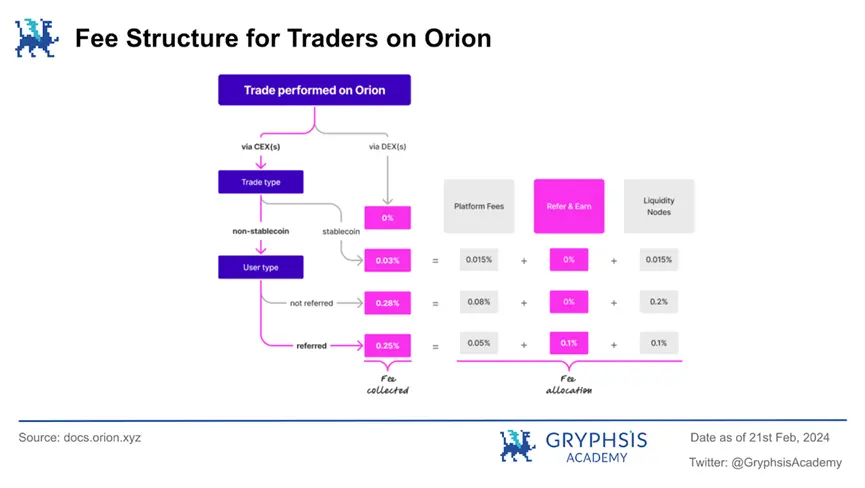
By implementing a multi-tiered reward system, Orion encourages chain referrals among users, promoting long-term community engagement and participation. The real-time distribution of rewards and additional incentives based on the leaderboard further enhance the appeal of the campaign, stimulating active user participation. This long-term user engagement and community building are crucial for the platform's stable growth and sustained development.
4.2 BRC Cross-Chain Bridge and BTCFi Pioneer
According to OrdSpace data, there are currently over ten thousand BRC20 tokens with a total market capitalization exceeding twenty billion dollars, demonstrating the market's popularity and high demand for such assets. As a cross-chain bridge connecting Bitcoin and other blockchain networks (such as Ethereum, BNB Smart Chain, etc.), Orion is one of the few infrastructures supporting the BRC20 standard, giving Orion a first-mover advantage in the market, helping to attract early adopters and investors.
Moreover, by supporting the BRC20 cross-chain bridge, Orion can attract users and developers looking to explore new financial products and services on the Bitcoin network. This cross-chain functionality will significantly increase liquidity and trading volume on the Orion platform.
The introduction of the BRC20 cross-chain bridge enables Orion to support the creation and transfer of fungible tokens on the Bitcoin network, providing an important foundation for the development of the BTCFi ecosystem. This not only increases the use cases and value of Bitcoin but also brings Orion a unique opportunity to connect BTCFi with the broader DeFi ecosystem.
With the rapid development of the BTC ecosystem last year, we anticipate that BTCFi will be a rapidly growing track, and Orion may therefore have strong growth potential through its cross-chain bridge products.
4.3 Anticipated Airdrop for Orion Terminal
In September 2020, Uniswap announced an airdrop of its governance token UNI. All Ethereum addresses that interacted with Uniswap V1 or V2 before the airdrop deadline were eligible to receive at least 400 UNI.
Combining Uniswap's airdrop history and successful experience, if Orion Protocol considers implementing a similar airdrop strategy, we can foresee several potential growth points and positive effects, including but not limited to attracting new users, promoting community governance and engagement of existing users, increasing project exposure, acquiring new partners, obtaining effective user feedback, and facilitating its own technological improvements.
5. Token Economic Model
5.1 Token Distribution
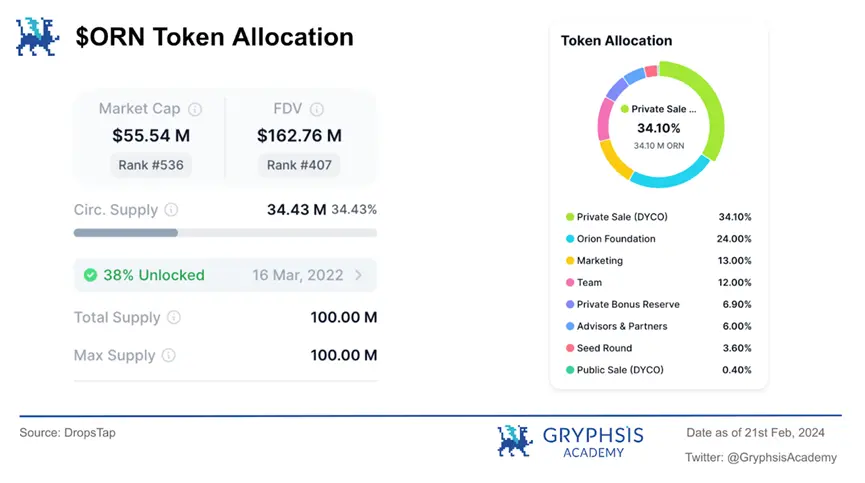
5.2 Token Utility
5.2.1 Staking & Governance
Orion Protocol's Governance 2.0 represents a fundamental transformation of its governance mechanism, aimed at building a resilient future that rewards commitment and ensures that every participant can contribute to Orion's long-term success through enhanced community interaction and influence. The core of Governance 2.0 is the introduction of veORN (Vote-Escrowed ORN), a non-transferable token that represents the ORN locked by users, equivalent to their voting rights and influence within Orion.
In the initial phase, veORN is primarily used for voting in liquidity pools, but its design is flexible and may expand to new governance capabilities as the Orion ecosystem develops. The veORN mechanism encourages users to increase their participation and influence in Orion governance by locking ORN for the long term, thereby strengthening community members' control over the platform's development direction.
Users obtain veORN by staking ORN and choosing a lock-up period, further participating in Orion's governance process. The choice of lock-up period reflects the depth of the user's commitment to Orion governance, with longer lock-up periods yielding more veORN, thus enhancing the user's influence in governance decisions. This mechanism aims to reward users with long-term commitments to the Orion ecosystem, ensuring that rewards are proportional to the level of participation and depth of commitment.
At the same time, the veORN decay mechanism introduced in Governance 2.0 aims to incentivize users to continue participating in Orion governance. Over time, veORN that is not further staked or extended will gradually decrease, requiring users to maintain or enhance their influence in governance by increasing ORN staking or extending the lock-up period. This design ensures the vitality and fairness of the Orion governance ecosystem, encouraging new user participation while rewarding existing users who are long-term and actively engaged.
5.2.2 Reward Mechanism
As an incentive in the Refer & Earn program: the fee generation from referrers (70% weight) and the user's ORN balance (30% weight). A higher ORN balance can significantly increase the rewards received.
6. Risks
6.1 Security Risks of Cross-Chain Bridge Technology
Cross-chain bridge projects in the DeFi space carry high risks, including security vulnerabilities and operational risks. As a cross-chain bridge project, Orion needs to pay close attention to these risks and implement corresponding security measures and risk management strategies to protect user assets and enhance community trust.
6.2 System Integration Risks
Orion Protocol provides its unique liquidity aggregation service by integrating multiple decentralized and centralized exchanges, a process that involves complex system integration work. While this integration offers users broad access to liquidity and an optimized trading experience, it also brings system integration risks.
These risks may include technical compatibility issues, as the APIs and data formats of different platforms may differ, requiring fine-tuning and adaptation to ensure seamless integration. Additionally, maintaining the stability and reliability of this integration is also a challenge, as any updates or failures from one platform could affect the operation of the entire system. This strategy, which heavily relies on external platforms, may be impacted by changes in policies or service interruptions from these platforms.
Therefore, while system integration brings significant advantages to Orion, such as richer liquidity and better user experience, it also requires Orion to invest continuous efforts to manage and mitigate these integration risks, ensuring the platform's stability and security, and protecting users' interests.
References
[1]https://docs.orion.xyz/overview/mission-and-vision
[2]https://trade.orion.xyz/dashboard/overview
【Disclaimer】This report is an original work completed by a student of @GryphsisAcademy @yelsanwong, with editing suggestions provided by Gryphsis Academy mentor @CryptoScott_ETH. The author is solely responsible for all content, which does not necessarily reflect the views of Gryphsis Academy or the organization that commissioned the report. Editing content and decisions are not influenced by readers. Please note that the author may hold cryptocurrencies mentioned in this report. This document is for informational purposes only and should not be considered as investment advice. It is strongly recommended that you conduct your own research and consult with neutral financial, tax, or legal advisors before making investment decisions. Remember, past performance of any asset does not guarantee future returns.










